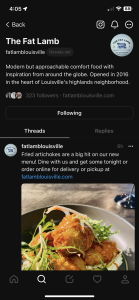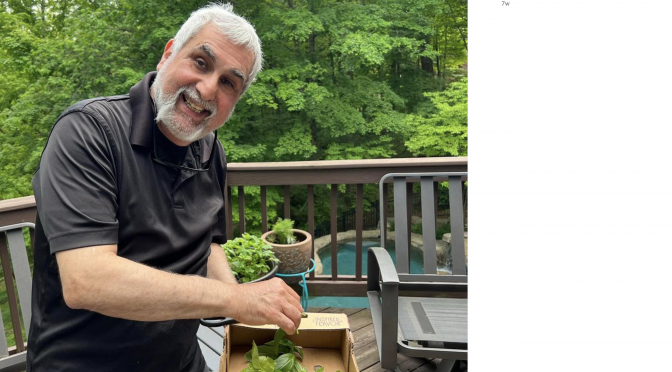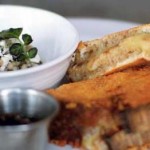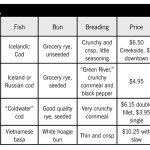By Robin Garr
LouisvilleHotBytes.com
In the overall scheme of things, it hasn’t been all that long since Tim Berners-Lee invented the World Wide Web. And it’s still recent history when Steve Jobs started the process of getting a tiny, powerful computer into everyone’s pocket.
How in the heck did we figure out how to eat before we could grab our smartphone and in a matter of seconds check out everything we wanted to know about where to go for dinner tonight and figure out what to have when we got there?
As recently as the 1980s, when I first wrote about restaurants for the old Louisville Times, a newspaper review was one of the few ways you could find out about the latest and greatest. If you’re reading this column, perhaps it still is, and I thank you!
Of course many places also advertised in the papers, and just about every eatery in town had a listing in the Yellow Pages. Remember those? The fancier or more assertive places paid up for larger display ads in that would stand out in that hefty, annually updated volume filled with tiny print.
Other than those dead-tree options, the occasional billboard, and fliers carried door to door, it was pretty much all word-of-mouth. It seemed to work, and the good news was that it didn’t cost the restaurant owner all that much to get the establishment’s name out there.
That was then. This is now.
That was then. Everything is different now. We want to know everything there is to know about every place we might want to eat. We want to know the hours, the location, what the place looks like, the dress code, and of course a full, accurate, current menu with detailed descriptions and prices.

Where do we want it? We want it on a website, Facebook, Instagram (like Anoosh Shariat’s post for his Anoosh Bistro, at the top of this page), and, increasingly, TikTok and even that spanking-new Twitter killer, Meta’s Threads. not to mention search engines like Google and Bing, reservation services like OpenTable, local online forums like LouisvilleHotBytes. And yeah, we still want to read media reviews, too. We’re still here and plan to stay, although looking around, this seems to be a declining art form.
From our perspective as consumers, this may seem like a golden age. Pull up an eatery’s website or Facebook page, follow it on Instagram, and we’ve got a ton of information to help us decide. We probably have good reason to doubt whether it’s 100 percent current – I recently checked a local eatery’s menu that cited a supplier I knew had been closed since last winter – but it’s a wealth of data that we never had before.
How does social media get paid for?
From the restaurateur’s perspective, though, this can’t be an unmixed blessing. In a business with narrow profit margins and unexpected costs lurking around every corner, advertising was a small but necessary budget line. Then came the Internet, and maybe for a while you could get by with the help of a tech-savvy kid crafting you a simple website. Ha! Not any more.
Costs vary widely, and a lucky executive may still know where to find that tech-savvy kid. But in a competitive market where you need to look professional or go home, it may cost $10,000 or more to set up a website, Facebook and Instagram pages and another couple of thousand to keep it up to date. That’s not a place to cut corners, either. You don’t want to make a potential customer angry before they even come in the door to discover the dish they wanted or the price they expected has changed.
It’s enough to make an owner throw up their hands and give the whole thing up. Who needs a website anyway? Only a restaurant executive who wants to survive, that’s all!
It takes money to make money, as the saying goes, and it’s necessary to be in the competition to lure those hungry diners in your doors. According to a survey cited in QSR, publication of the quick-service restaurant industry, nearly half (45 percent) of U.S. diners said they’ve tried a restaurant for the first time because of a social media post; and three-quarters said they actively follow and engage with restaurants on social media and are most likely to dine in or order food from the establishments that they follow.
“For restaurant marketers, it’s clear that high-quality social media content … has great relevance to consumers,” Ryan Goff at restaurant marketing agency MGH told QSR. “When done right, social content marketing can have great influence over where diners choose to spend their hard-earned money.”
How much is enough?
So, you’ve shelled out for your website and your Facebook page and made sure that they show up on Google Maps. Can you call it a day? Probably not. Instagram matters. According to Social Media Today nearly one-third of millennial diners “actively avoid restaurants with a weak Instagram presence. The power Instagram has on consumers’ purchasing behavior is continuously growing. This means that your business’s Instagram is just as important as your website.”
Nor can you stop there. According to Nation’s Restaurant News, Gen Z is showing a distinct preference for TikTok over Google Maps for deciding where to eat, thanks to “TikTok reviews’ immersive, authentic qualities. Users like TikTok because its seemingly endless content feels authentic and unfussy – videos made by real people, for real people. Creating ads that capture the candid nature of organic TikTok content helps businesses blend in and profit.”
And then there’s fast-growing Threads. “Many restaurant brands aren’t wasting any time trying to leverage the mass migration to Threads,” Nation’s Restaurant News observed in another article. What does having a presence here mean? Well, for starters, it means the brands that choose to join Threads will have to develop another content strategy for yet another social media channel.”
It never seems to end, but if you want to be seen, you’ve got to be there. Good luck, restaurant industry friends!




